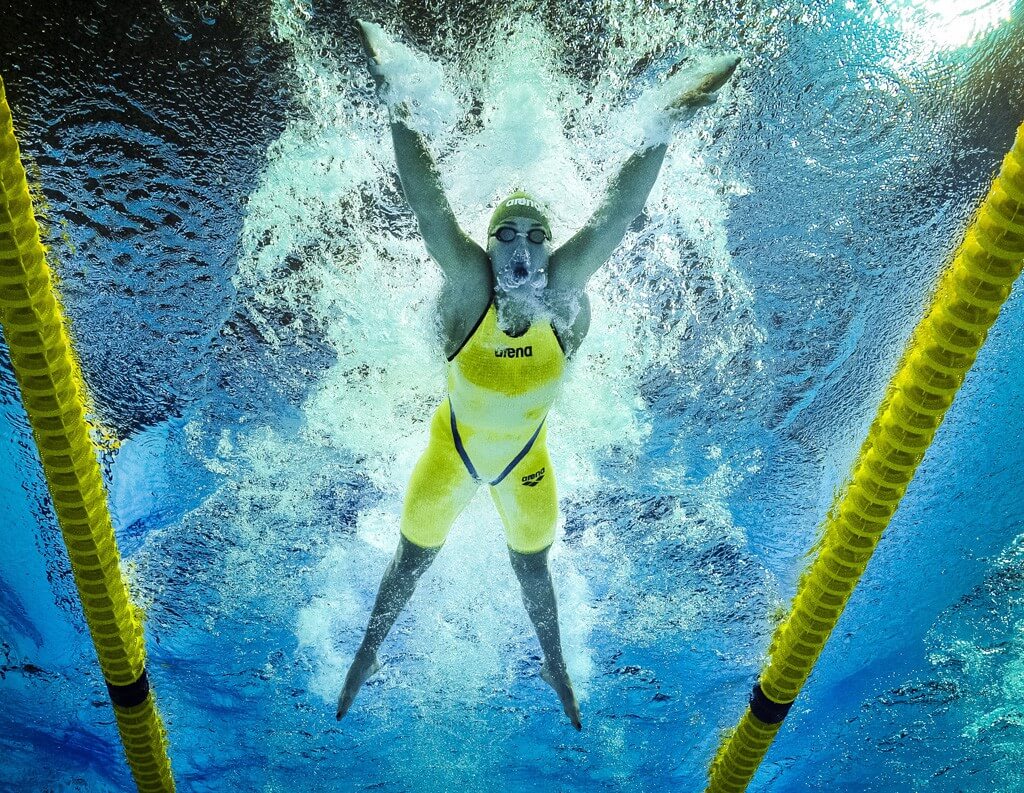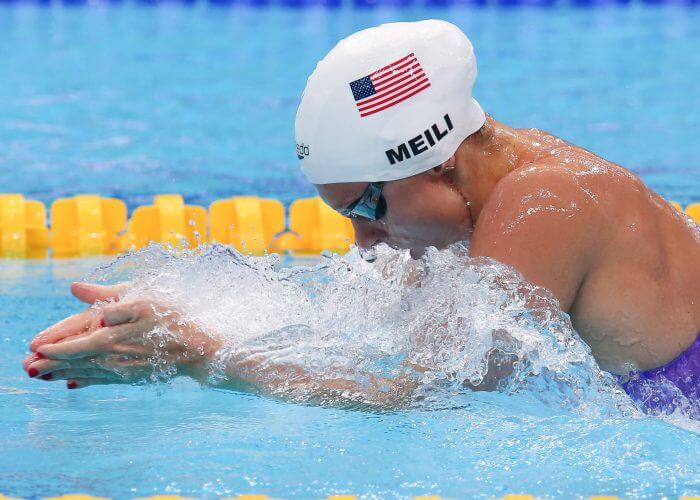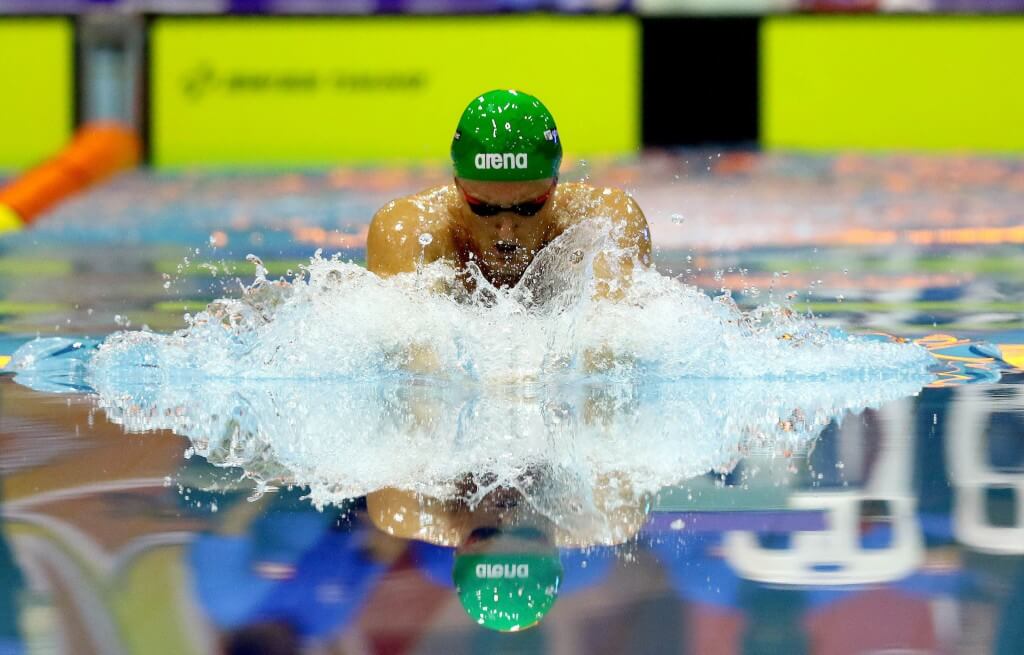The Evolution of Breaststroke

By Meaghan Raab, Swimming World College Intern.
There was time when I used to teach swimming through a program with my club team. Breaststroke was always the hardest stroke to teach the kids because of the differences in the stroke from the other three strokes. Freestyle and backstroke are essentially the same stroke, with the exception of freestyle swum on the stomach and backstroke swum on the back. The simple description of butterfly is both arms and legs at the same time. Breaststroke is completely different.
Breaststroke has been around for a long time with the origin tracing back to the Stone Age. There was even an Egyptian cave found, affectionately known as “The Cave of Swimmers”, which has paintings on the wall with people that are swimming breaststroke.
Breaststroke is the slowest of the four strokes due to the timing of the stroke. However, it is still quite competitive and fun to watch with big names like Lilly King, Adam Peaty, and the newest member of the elite breaststroke group Caeleb Dressel. It does however requires strength and stamina in order to get back up to speed with each stroke cycle.
The arm motion of the stroke is simple enough to master. I used to tell my swimmers to “scoop the Hershey’s kisses, eat the kisses, and spit the wrappers out” in order to get them to understand the concept. You skull your hands out forming a “Y”, then sweep your hands back in toward your body, and then shoot your hands forward.
The challenging part is the kick, because it is unnatural and requires flexibility in the hips and ankles. Lift your feet up towards your butt with feet turned outwards, then sweep outward and bring them back together behind your body with feet together and toes pointed.
There is a sort of finesse or rhythm to breaststroke where each swimmer is a little bit different when swimming the stroke. This timing can be challenging to master as a young swimmer, but watching the experienced and elite swimmers showcases the different ways of swimming the stroke. Some people choose a more “wave-like” technique with undulation like Molly Hannis, or movement of the body similar to that of butterfly. Others choose a more straight and forward motion, like Katie Meili.

Photo Courtesy: SIPA USA
The first breaststroke race was in the 1904 Olympic Games in St. Louis. There was only one race, the 440-yard breaststroke for men. Four years later, the men’s 200-meter breaststroke was contested. It wasn’t until 1924 at the Olympics in Paris that the women were able to swim a breaststroke event. Since the 1968 Games in Mexico City, the 100-meter and 200-meter have been contested for men and women.
David Armbruster did a study in 1928 where he found that performing the recovery part of the stroke is faster over the top of the water than underneath the surface. In the 1930s, swimmers used this technique in competition. They started swimming a breaststroke kick and what would be known as normal butterfly arms. In 1952, the combined stroke split into butterfly and breaststroke because the combination violated the rules created.
There would be more rule changes in the coming years. FINA created a rule in the 1960s making sure that the swimmers’ arms did not go past the hips, except for the first stroke out of the start, the turns and in the pullout.
The year 1987 brought a rule that swimmers no longer needed to keep their heads above the water. The swimmers must break the surface of the water on each stroke cycle, but put their head back into streamline for a faster forward motion. The former rule about keeping your head above the water affected the shape and size of people who could swim breaststroke. These swimmers either needed to be light so they could float and stay above the water or strong enough to push themselves forward in the race.
In the 1990s the swimmers began to throw their hands over the surface of the water as they recovered. This was determined to be allowable as long as the elbows didn’t break the surface of the water.
It wasn’t until 2004-2005 that FINA decided to rule in favor of doing one dolphin kick at the start and off of each wall in the pullout. This came after the controversy that arose after Kosuke Kitajima did a single dolphin kick off the start and turn in the final of the 100-meter breaststroke in the 2004 Olympic Games in Athens. The kicks were not visible above the water which meant that the officials could not disqualify him, as the benefit of the doubt goes to the swimmer in instances of uncertainty.
The dolphin kick rule has not been without controversy as there was underwater video footage that showed Cameron Van Der Burgh of South Africa doing three dolphin kicks off the start in his gold-medal race of the 100 breast in London. He even admitted to doing so in an interview after the race.

Photo Courtesy: Anesh Debiky/Swimming South Africa
Ten years later the dolphin kick rule was tweaked. This change would allow for the dolphin kick to happen at any point before the breaststroke kick. The old rule mandated the hands to separate before the dolphin kick. There is no rule that states that a pullout is necessary. Some coaches may have their swimmers skip the pullout in longer events like the 400 IM, particularly if they are not breaststrokers.
Breaststroke may have a lot of strict rules about the technique and completion of the stroke in the races, such as two-hand touch, but it is the only stroke that does not require the swimmer to break the surface at the 15-meter marker.
All commentaries are the opinion of the author and do not necessarily reflect the views of Swimming World Magazine nor its staff.




Interesting article. In supervising swim instruction for thousands
Of first and fourth graders over twenty years and coaching age group swimmers for over ten years it became apparent that young children with learning disabilities frequently swam, with no instruction, a natural breast stroke kick, even adapting it modified Breast stroke kick into their freestyle. It would be interesting to know if others encountered this. The old ARC materials claimed the paired movement simpler—no proof that I know of.
Good write up but I totally disagree with comparison of freestyle being the same as backstroke.